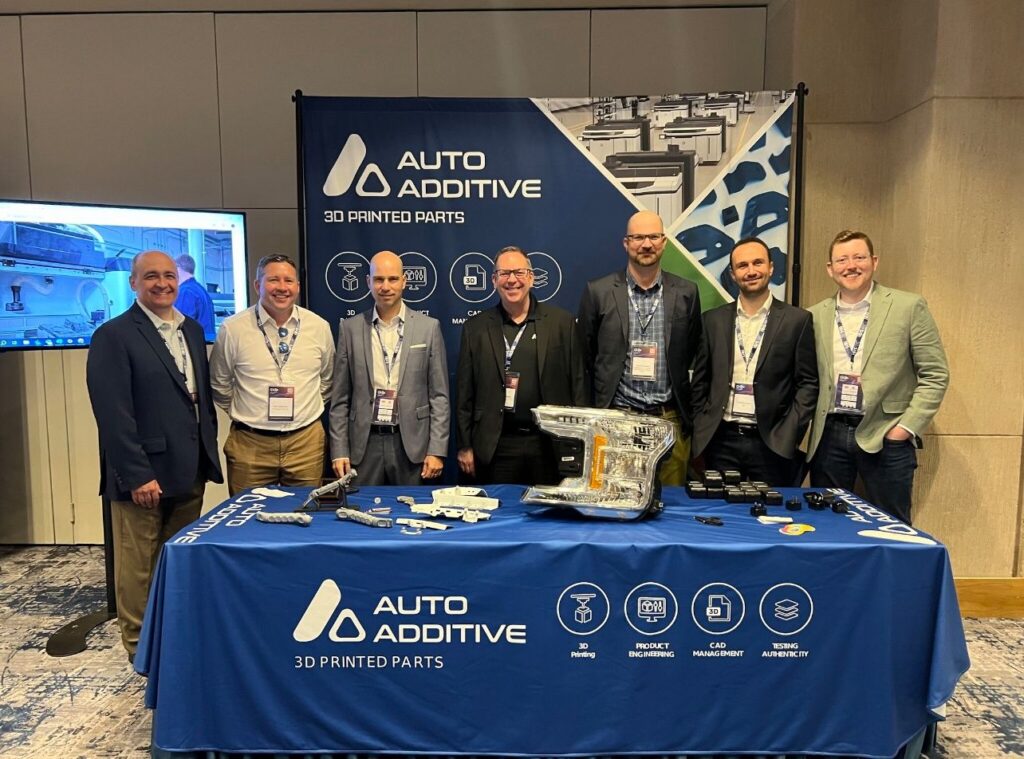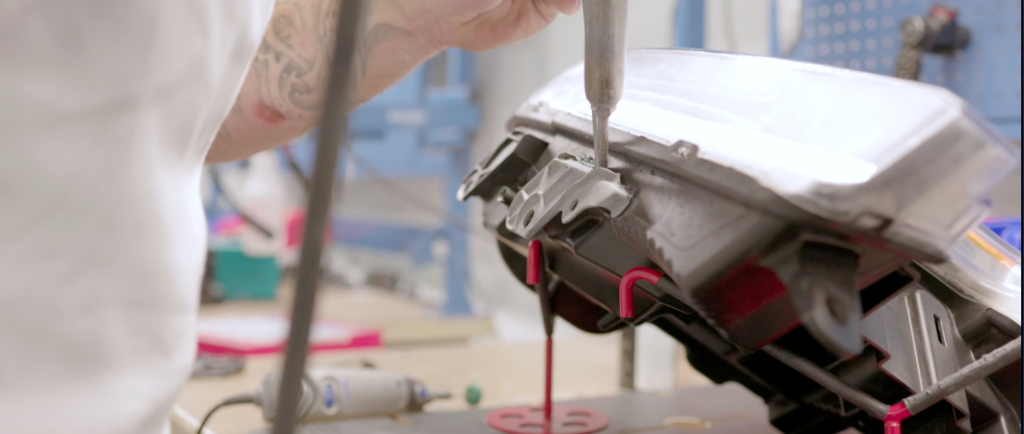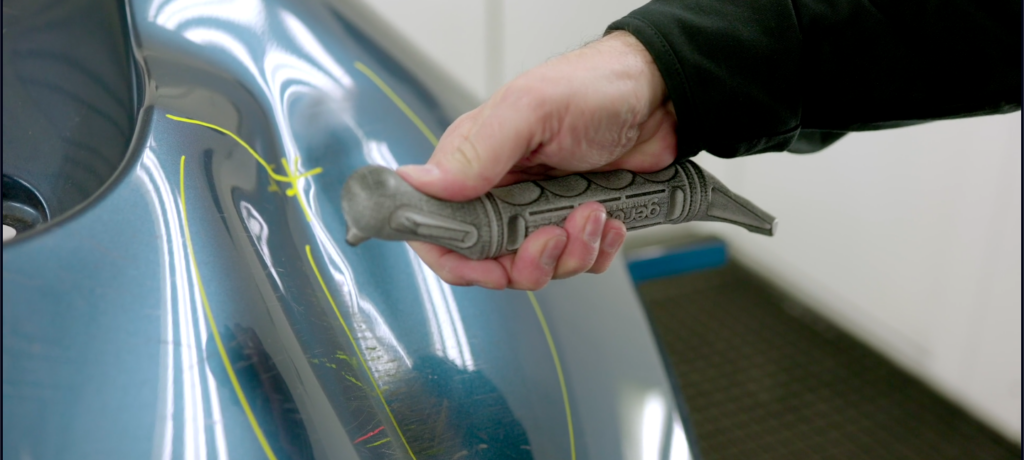Despite the automotive sector’s long-time adoption of additive manufacturing (AM), the use of the technology for end parts in consumer vehicles is only just now beginning to take off. And, in the aftermarket, where 3D printing has particular potential for enabling repairs, widespread adoption has been even slower.
Thankfully, born out of the 3D Printing in Auto Repair Task Force, a new service company has emerged to tackle this issue. With former Ford AM veteran Harold Sears as head of the advisory board, Auto Additive has the potential to transform the auto repair industry with 3D printing. To learn more, we spoke to Sears, who shed light on the company’s mission and vision.
Auto Additive Launches at IBIS Global
Auto Additive was launched at International Bodyshop Industry Symposium (IBIS) Global in May 2024 as the first 3D printing and engineering services company dedicated to auto repair. The company, in collaboration with partners such as HP, Headlights.com, 4Plastic Inc., and GKN Additive, showcased several 3D printed tools, jigs, and repair parts. One of the standout products was the 3D printed weldable and attachable headlight repair tab kit, which is an industry-first and will be available exclusively on Headlights.com in the USA.
“These tabs are weldable directly onto the headlight, due to new advancements in polypropylene material for 3D printing, something that was previously a struggle with traditionally made and 3D printed headlight repair tabs,” Sears said.

Auto Additive uses a form of blockchain technology to transfer data securely to printing partners. “The data is transferred directly to a printer in one of the service providers in our network, and once the printing is completed, the blockchain technology will remove the print from their queue,” Sears explained. This ensures that each part produced is identical in quality and specifications to the last, addressing a common issue in the industry.
At the event, Auto Additive also demonstrated a plastic repair push tool designed to enhance precision and efficiency while reducing labor costs, and metal 3D printed bumper side tab jigs that can be easily attached, eliminating the need for complete bumper replacements. Another notable innovation was the 3D printed weld-on polypropylene tabs for headlights, which allow for headlight restoration to industry standards without full replacements, thus cutting costs and reducing waste.

3D printed headlight tabs
According to Sears, the IBIS launch was extremely well received. “There were around 300 people in the audience, and the presentation logged more questions than any other,” Sears shared. The response highlighted the need for innovation in the auto repair industry, which has largely been overlooked by the 3D printing world.
Sears noted that the auto repair industry has not fully embraced 3D printing for parts, tools, fixtures, and jigs. “The industry really needs this,” he asserts. Auto Additive aims to fill this gap, providing engineering services to help specialty collision repair suppliers and auto repair shops understand and utilize 3D printing effectively.
From Industry Study to Action
Sears explained that the foundation of Auto Additive came from the first study conducted by the 3D Printing in Auto Repair Task Force, which thoroughly examined the industry’s needs. The goal was to find a technology that could produce parts comparable to those made by traditional methods, with proper validation rather than just printing and assuming they were adequate.
Once the report was published, initial interactions with standard-setting organizations were met with resistance. Sears described these encounters as “cold and stiff-armed,” with some organizations suggesting fee-based or membership-based tech groups, which did not align with Auto Additive’s vision. “This is not a pay-to-play situation; this is something the industry needs,” Sears emphasized.

Bumper tab welding jig
The turning point came when presented with a business opportunity, Sears and other members of the task force decided to take on this offer and help create the new business model. “Sometimes the answer is right in front of you, and you don’t realize it,” Sears recalls. This realization led to the creation of Auto Additive, focusing on safe and transparent parts distribution for the automotive repair industry, using blockchain technology to secure data and ensure consistent quality.
Advisory Council and Future Plans
Still in its early days, Auto Additive has established an advisory council comprising industry experts from companies like HP, PPG, Tesla, and Assembrix, the blockchain technology provider. “We’re trying to pick high-level people who are important to this industry,” Sears said. This council will guide the company’s development and ensure that their solutions are aligned with industry needs.
Currently, Auto Additive operates with several employees and plans to utilize HP’s printing network globally. “Our goal is to print parts locally in select regions to reduce shipping and improve efficiency,” Sears explained. This approach will enable the company to meet global demand without centralizing production.

Sears acknowledged the challenges ahead, particularly in gaining acceptance from established companies. “Right now, we’re just launching, creating customer success stories, proving our concepts, and establishing a business plan,” he said. However, he remains optimistic about future collaborations and partnerships.
Sears emphasized the importance of validating the firm’s approach and gaining industry acceptance. “We need to show how valid we are,” he said. With a seat on their advisory council from an OEM like Toyota, large-scale MSO’s such as Boyd Group, Auto Additive is poised to build credibility and demonstrate its capabilities.
Auto Additive’s strategy includes developing a comprehensive database of tested applications and results. Sears envisions returning to standards groups in the future with this data to collaborate on setting industry standards.
Broadening Horizons
Auto Additive is not only focused on polymer parts, nor only technologies offered by HP. “We’re using laser powder bed fusion for a solution on a fixture right now,” Sears reveals. The company’s flexible approach allows it to adopt the best technology for each application.
Auto Additive is set to significantly advance the auto repair industry by integrating advanced 3D printing technology and blockchain for secure, consistent parts production. With a strong advisory council and a focus on industry collaboration, Auto Additive aims to address long-standing challenges in auto repair and pave the way for future innovations.
“We’re on a journey to help the auto repair industry,” Sears concludes. “3D printing is a tool that hasn’t been utilized well, and we’re here to change that.”
Subscribe to Our Email Newsletter
Stay up-to-date on all the latest news from the 3D printing industry and receive information and offers from third party vendors.
Print Services
Upload your 3D Models and get them printed quickly and efficiently.
You May Also Like
Nikon Advanced Manufacturing & ASTM International Form Partnership to Bolster U.S. Defense Supply Chain
Nikon Advanced Manufacturing Inc., the California-based, end-to-end metal additive manufacturing (AM) company, has signed a Memorandum of Understanding (MoU) with standards organization ASTM International to work together on multiple efforts...
Ruggedized: How USMC Innovation Officer Matt Pine Navigates 3D Printing in the Military
Disclaimer: Matt Pine’s views are not the views of the Department of Defense nor the U.S. Marine Corps Throughout this decade thus far, the military’s adoption of additive manufacturing (AM)...
BlueForge Alliance’s Tim Shinbara – a Driving Force for Defense Manufacturing
After an influential history within the manufacturing industry as VP and CTO of the Association for Manufacturing Technology (AMT), and a former (2020-2021) ASME Congressional Fellow in manufacturing, Tim Shinbara...
Have it Your Way: Spokbee Founder & CEO Mac Cameron Makes the Case for CPQ Software in 3D Printing
Configure Price Quote (CPQ) software automates the process of tailoring goods and/or services to customer specifications, determining the price of the product configuration, and providing the customer with a quote...



































